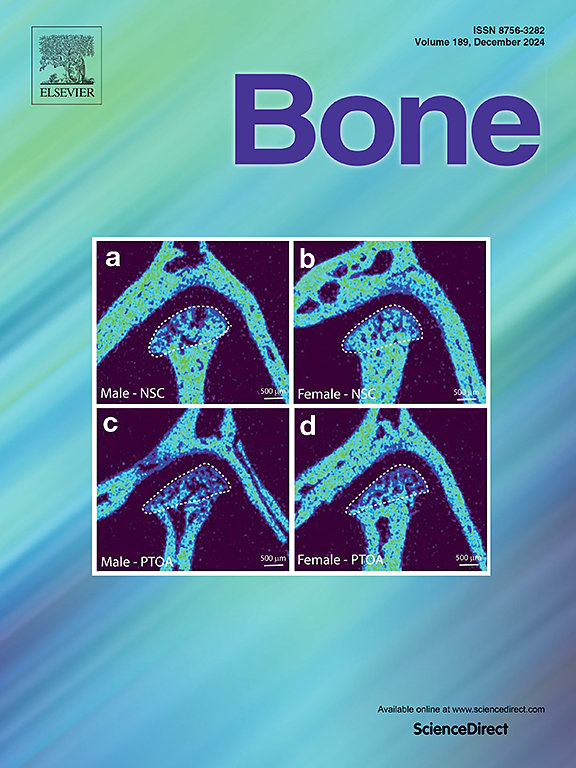Characteristics of patients with very high fracture risk in a community-dwelling geriatric cohort
IF 3.5
2区 医学
Q2 ENDOCRINOLOGY & METABOLISM
引用次数: 0
Abstract
Objective
Bone anabolic treatment has been shown to be superior to oral bisphosphonates, especially in osteoporosis patients with a very high fracture-risk. The current German osteoporosis guideline classifies the very high 3-year fracture-risk based upon a novel fracture-risk model. As age is a severe risk-factor, we examined the distribution and associations to geriatric assessment parameters of the very high-risk group in a well-characterized cohort of community-dwelling geriatric patients.
Methods
Analyses were based on 166 patients (mean age 82 ± 6 years) taken from MUSAR (MUnich SArcopenia Registry). Fracture-risk was calculated as described in the current German guideline. Thereupon, patients were allocated to the low−/moderate (<5 %), high- (5–10 %) or very high-risk group (>10 %). Associations of geriatric assessment parameters with the group allocation to the fracture-risk group were evaluated by covariate-adjusted linear regression analysis.
Results
>80 % of the study population were at an increased fracture-risk. Besides, >50 % were allocated to the very high-risk group. Patients in the very high-risk group showed limitations in all physical performance tests (short physical performance battery (SPPB), gaitspeed, handgrip strength and chair rise test). Also, polypharmacy and a risk for malnutrition (from mini nutritional assessment short form (MNA-SF)), were present. All parameters showed significant associations with group allocation to very high-risk group.
Conclusion
Most of the geriatric patients are at a very high-risk for osteoporotic fractures. Also, this group presented several limitations in the comprehensive geriatric assessment highlighting the vulnerability of this group. Clinicians need to reinforce fracture-risk assessment and familiarize with treatment options.
社区居住老年队列中极高骨折风险患者的特征。
目的:骨合成代谢治疗已被证明优于口服双膦酸盐,特别是对于骨折风险非常高的骨质疏松症患者。目前的德国骨质疏松症指南根据一种新的骨折风险模型对极高的3年骨折风险进行了分类。由于年龄是一个严重的危险因素,我们在一个特征明确的社区居住老年患者队列中检查了高危组的分布及其与老年评估参数的关联。方法:分析来自MUSAR (MUnich SArcopenia Registry)的166例患者(平均年龄82 ± 6 岁)。骨折风险按照德国现行指南进行计算。因此,患者被分配到低/中度(10 %)。通过协变量调整线性回归分析评估老年评估参数与骨折风险组分组分配的关系。结果:bbb80 %的研究人群骨折风险增加。此外,bbbb50 %分配给高危组。高危组患者在所有体能测试(短时间体能测试(SPPB)、步态速度、握力和椅子上升测试)中均有局限性。此外,多种用药和营养不良风险(来自迷你营养评估简表(MNA-SF))也存在。所有参数均与高危组的分组有显著相关性。结论:大多数老年患者是骨质疏松性骨折的高危人群。此外,这一群体在全面的老年评估中提出了一些局限性,突出了这一群体的脆弱性。临床医生需要加强骨折风险评估并熟悉治疗方案。
本文章由计算机程序翻译,如有差异,请以英文原文为准。
求助全文
约1分钟内获得全文
求助全文
来源期刊

Bone
医学-内分泌学与代谢
CiteScore
8.90
自引率
4.90%
发文量
264
审稿时长
30 days
期刊介绍:
BONE is an interdisciplinary forum for the rapid publication of original articles and reviews on basic, translational, and clinical aspects of bone and mineral metabolism. The Journal also encourages submissions related to interactions of bone with other organ systems, including cartilage, endocrine, muscle, fat, neural, vascular, gastrointestinal, hematopoietic, and immune systems. Particular attention is placed on the application of experimental studies to clinical practice.
 求助内容:
求助内容: 应助结果提醒方式:
应助结果提醒方式:


